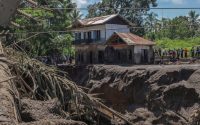‘We Still Have Hope’: Rescuers Race to Find Dozens Missing in South Africa Building Collapse
It may not have been his dream, but Gift Kasonda was happy to have been working as a laborer on a construction site in South Africa’s coastal city of George. A recent high school graduate, he had emigrated from Malawi last year and was hoping to save money for college, said his uncle, Gracium Msiska.
Now his family is left wondering whether those hopes have been dashed. The four-story building under construction where he was working collapsed in a thunderous instant on Monday, killing at least eight people and leaving dozens of others, including Mr. Kasonda, missing.
As the search for survivors passed the 72-hour mark on Thursday, the screams for help from beneath the rubble that offered signs of life in the early hours of the collapse faded. But rescuers were still desperately combing through some 3,000 tons of concrete. As of Thursday afternoon, 29 of the 37 people pulled from the wreckage had survived and 44 people were still missing, according to the authorities.
Investigators have only just begun the work of trying to figure out what caused the building to come down. For now, many relatives of the missing, like Mr. Msiska, are focused on the race against time to find survivors — enduring sleepless nights and simply praying for the best.
Mr. Msiska said his nephew, who is 18 or 19 years old, arrived in South Africa last October, settling in the same township just outside George where he has lived since 2019, when Mr. Msiska himself came from Malawi in search of economic opportunities.
“You know, life back home, it’s very difficult,” Mr. Msiska said by phone. “He was trying to survive. He’s still a young boy, he’s still chasing his dreams. We were all happy.”
On his way home from work on Monday, Mr. Msiska said, he got a call from his sister, who was crying so hard that he could not understand what she was saying. He was able to discern from someone else that the building where his nephew worked had collapsed.
He said he rushed to the scene, where he found his sister inconsolable. Many other relatives of workers who had been in the building were also there, praying and being comforted by social workers.
Mr. Msiska said he was shocked at the sight of the building: heaps of concrete pancaked onto the ground.
“I couldn’t believe there would be some people who would be alive,” he said.
But there was hope in those initial hours. Rescuers could hear noises beneath the surface and were able to locate victims. Some of the trapped workers were able to make phone calls to loved ones and the authorities. Slowly, people were pulled from the rubble — alive.
A day after the collapse, Vuyokazi Fuba got a phone call that ended what had been a terrifying and tearful 24 hours: It was her brother, 32-year-old Lunga Sindelo, calling from the hospital to say he had survived the collapse.
She rushed to go see him, she said. He was physically unharmed, she said, but mentally he was struggling. He was very quiet and still seemed scared.
Ms. Fuba said he told her that he had heard a noise and then the building started to shake. The next thing he knew, all the concrete had collapsed around him and he was in the dark, crying. One person died in front of him, Ms. Fuba said he told her.
“I’m not good,” she recalled her brother saying. He has since gone to Cape Town, where his other sister lives, to get counseling, Ms. Fuba said.
George, with a population of nearly 300,000, sits in the shadow of the Outeniqua mountain range, along the Indian Ocean. It is part of the Garden Route, a scenic drive that draws a lot of tourists.
The building that collapsed was meant to house two-bedroom apartment units that were selling for about 1.7 million rand each (about $92,000), according to local media reports. It was slated to open in August.
Rescue efforts at the site over the past three days have been complicated by the instability of the massive amounts of concrete that piled up around an elevator shaft in a volcano-like mound, according to Colin Deiner, the chief director of disaster management for the Western Cape Province who is leading the rescue operation. He said demolition equipment was being brought to the scene on Thursday to help remove the concrete.
Mr. Deiner said there were about 200 people on the search team. They had been using seismic equipment and search dogs to try to locate victims, he said, but were no longer picking up any sounds beneath the rubble. On Monday, they spoke to a trapped worker who called from his cellphone, but they had not yet been able to locate him, Mr. Deiner said.
Although by international standards the effort should transition from rescue to recovery mode after three days, Mr. Deiner said, he was hopeful that some of the victims could survive longer.
In the meantime, Mr. Msiska said, he is fielding a lot of calls from relatives in Malawi.
“Everybody’s waiting for the good news,” he said. “And now, I’m even tired of answering the calls from home because I don’t have anything to explain.”
Still, Mr. Msiska said, he remains optimistic that the good news will come.
“We still have hope,” he said, “and we trust in God.”


